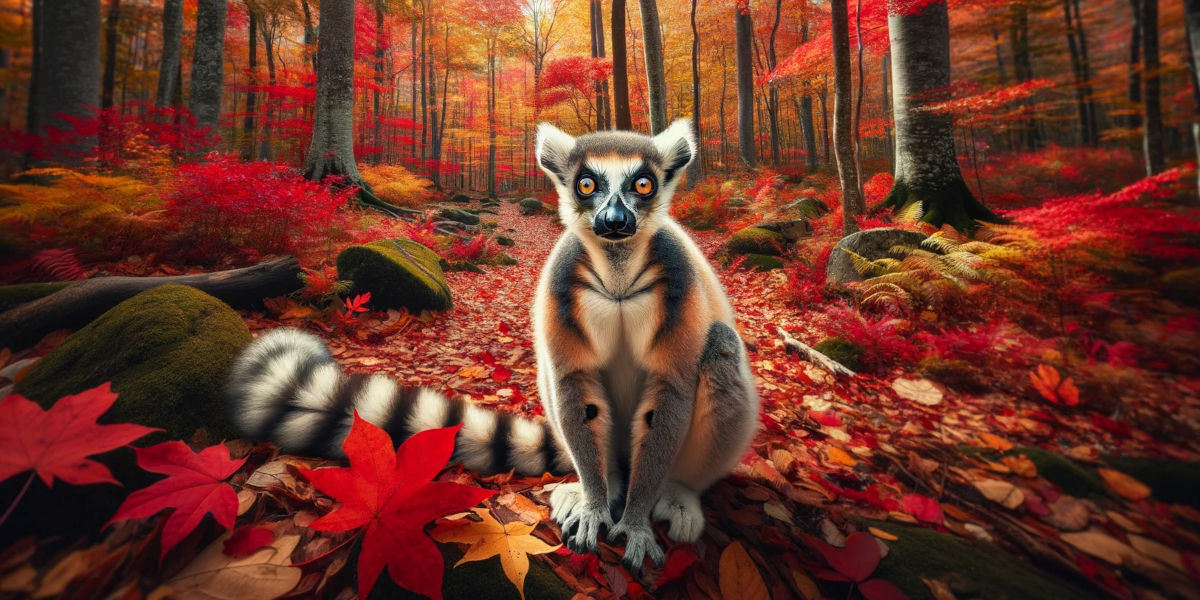
Introduction
Lemurs, primates that are native to Madagascar, have long captivated our imagination. These animals, with their large, expressive eyes and playful demeanor, are not only a key part of Madagascar’s unique biodiversity but also a window into primate evolution.
One of the most fascinating aspects of lemurs is their adaptive behaviors and physiological traits, particularly in relation to their vision. This brings us to a compelling question: Can lemurs see in the dark?
The answer, while not completely straight forward, is quite intriguing. Many lemur species are indeed nocturnal, suggesting a certain level of adaptation for low-light environments.
However, the extent of their night vision capabilities varies across different species. Some lemurs, especially those active at night, have evolved eyes that are more sensitive to dim light, enabling them to navigate after sunset. Yet, this does not necessarily mean they see in the dark with the same clarity as some other nocturnal animals.
In this article, we take a closer look at the night vision capabilities of lemurs.
Understanding the Vision of Lemurs

Anatomy and Adaptation of Lemur Eyes
The eyes of lemurs are a marvel of evolutionary adaptation, providing crucial insights into their survival strategies. Structurally, lemur eyes share several common features with other primates, including a rounded lens and a retina with photoreceptor cells.
However, it’s the specific adaptations of these photoreceptors that make their vision unique. Lemurs predominantly have rod cells in their retinas, which are more sensitive to light and motion than color-detecting cone cells. This rod dominance is particularly pronounced in nocturnal species, enabling them to see better in low-light conditions.
Another fascinating aspect of lemur eye anatomy is the presence of a reflective layer behind the retina, known as the tapetum lucidum. This layer, common in many nocturnal animals, acts like a mirror, reflecting light back through the retina and enhancing vision in the dark.
The tapetum lucidum is what gives lemurs and other nocturnal animals their characteristic eye shine when caught in a beam of light.
The size and shape of a lemur’s eyes also contribute to their nocturnal capabilities. Larger eyes can gather more light, which is why nocturnal lemurs tend to have bigger, more prominent eyes compared to other similar animals.
Lemur Eyesight Compared to Other Nocturnal Animals
When comparing lemur vision to that of other nocturnal animals, it’s clear that while lemurs are well-adapted to their environments, they might not have the same level of night vision as some other species.
For instance, owls and certain nocturnal felines have a higher density of rod cells and a more pronounced tapetum lucidum, enabling them to see with greater clarity in near-total darkness.
Lemurs, in contrast, while able to navigate during twilight and in dimly lit environments, may not have the same strength of night vision. This difference is partly due to the evolutionary paths these animals have taken.
While the likes of owls and cats evolved primarily as nocturnal predators with a need for precise vision in darkness, lemurs evolved as omnivorous foragers, with their vision adapting to a balance of day and night activities in diverse forest environments.
It’s also important to note the diversity among lemur species themselves. Some, like the mouse lemurs, have adapted more thoroughly to nocturnal life, with eyes better suited to darkness. Others, like the ring-tailed lemur, are more active during the day, and their vision is tailored accordingly.
In summary, while lemurs are not the champions of night vision in the animal kingdom, their eyes are fascinating adaptations that allow them to thrive in their unique environments.
Different Types of Lemurs and Their Vision Capabilities

Variations in Nocturnal Behavior Among Lemur Species
Lemurs showcase a remarkable diversity in their activity patterns, which directly influences their vision capabilities. Broadly classified, lemurs can be nocturnal, diurnal, or cathemeral (active at various times throughout the day and night).
More nocturnal lemurs, such as the mouse lemur and the aye-aye, are active primarily during the night. These species have developed eyes that are more adapted to low-light conditions, allowing them to efficiently forage and navigate in the dark.
Diurnal lemurs, like the ring-tailed lemur and the sifaka, are active during the day. These lemurs have a vision more attuned to daylight hours, with a better perception of colors and details required for daytime activities.
Cathemeral species, such as the common brown lemur, display sporadic activity patterns, being active at various times both day and night. These lemurs have a more balanced eye structure, allowing them to adapt to changing light conditions.
How Different Types of Lemurs Adapt to Low-Light Environments
Adaptation to low-light environments among lemurs varies significantly across species, driven by their specific ecological needs and evolutionary history.
Nocturnal species, with their large eyes and high rod density, are well-suited to detect movement and navigate in the dark. However, their vision is generally monochromatic, focusing more on light sensitivity than color differentiation.
For diurnal species, low-light adaptation is less about seeing in complete darkness and more about dawn and dusk activities. These lemurs have a vision that works well in bright light but also allows them to manage during reduced light conditions at sunrise and sunset.
Cathemeral lemurs, with their varied activity patterns, showcase a unique adaptation. Their eyes are not as specialized as strictly nocturnal or diurnal species. Instead, they possess a versatile visual system capable of functioning reasonably well under a range of lighting conditions.
Overall, the diversity in vision capabilities among lemur species highlights the complexity of their adaptation to the unique challenges posed by their habitats. It underlines the importance of understanding each species within its ecological context to appreciate fully how they have evolved to see in their world of varying lights and shadows.
Scientific Studies on Lemur Night Vision

Summary of Research Studies or Cases Related to Lemur’s Ability to See in the Dark
Recent scientific studies have shed light on the night vision capabilities of lemurs. These studies typically involve a combination of anatomical examinations, behavioral observations, and sometimes controlled experiments in both natural and laboratory settings.
One key finding is the variation in eye structure across different lemur species, which correlates with their activity patterns. For instance, research shows that nocturnal lemurs have a higher proportion of rod cells in their retinas, which are more sensitive to low light, compared to diurnal species.
Another discovery is the presence of the tapetum lucidum in nocturnal lemurs, which reflects light through the retina, enhancing their ability to see in low-light conditions. This feature is less developed or absent in diurnal species.
Behavioral studies have also revealed how nocturnal lemurs adjust their activity patterns based on moonlight and starlight, indicating a reliance on available natural light for navigation and foraging. This observation suggests that while they have adapted to see in the dark, their night vision is not as acute as in some other nocturnal species.
Insights from Experts in Primate Biology and Nocturnal Animals
Experts in primate biology and nocturnal animal behavior offer valuable insights into the significance of these research findings. They emphasize that lemurs, as primates, have a unique evolutionary path that has influenced their visual adaptations.
Primatologists highlight the ecological importance of these adaptations. Lemurs have evolved to fill various ecological niches in Madagascar, and their vision plays a key role in how they interact with their environment, find food, and avoid predators.
Experts also point out that studying lemur vision helps in understanding the broader context of primate evolution, particularly how different species adapt to their environments. The study of lemurs offers a glimpse into the diverse ways primates can evolve to meet the challenges of their habitats.
The research on lemur vision, complemented by expert insights, paints a picture of a group of animals perfectly adapted to their environment. It highlights the balance between inherited primate traits and the specific adaptations required to thrive in the challenging environments of Madagascar.
Conclusion
The exploration into the night vision capabilities of lemurs reveals some fascinating insights into evolutionary biology, ecology, and behavioral science.
While lemurs do not possess night vision as advanced as some specialized nocturnal animals, they do possess some ability to see in the dark, which is finely tuned to their specific ecological needs and lifestyles.
Lemurs exhibit a remarkable range of adaptations in their vision, closely tied to their diverse lifestyles – from strictly nocturnal to diurnal, and even cathemeral. This diversity underscores the evolutionary ingenuity of these primates in adapting to the various challenges of their habitats.
While nocturnal lemurs can see in low-light conditions thanks to adaptations like a higher proportion of rod cells and the tapetum lucidum, their night vision serves more for navigation and foraging rather than detailed perception. This adaptation is a testament to their evolutionary journey and survival strategies.
In conclusion, the question, “Can lemurs see in the dark?” opens the door to a deeper understanding of these unique primates. Lemurs, with their varied and adaptive vision, continue to intrigue and educate us about the complexities of nature and the wonders of evolutionary adaptation.




